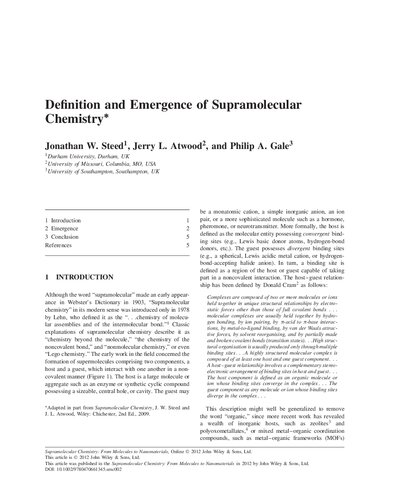

Most ebook files are in PDF format, so you can easily read them using various software such as Foxit Reader or directly on the Google Chrome browser.
Some ebook files are released by publishers in other formats such as .awz, .mobi, .epub, .fb2, etc. You may need to install specific software to read these formats on mobile/PC, such as Calibre.
Please read the tutorial at this link: https://ebookbell.com/faq
We offer FREE conversion to the popular formats you request; however, this may take some time. Therefore, right after payment, please email us, and we will try to provide the service as quickly as possible.
For some exceptional file formats or broken links (if any), please refrain from opening any disputes. Instead, email us first, and we will try to assist within a maximum of 6 hours.
EbookBell Team

4.8
94 reviewsSupramolecular chemistry is 'chemistry beyond the molecule'. While traditional chemistry focuses on the bonds that hold atoms together in a molecule, supramolecular chemistry examines the weaker interactions that hold groups of molecules together. Important concepts that have been demonstrated by supramolecular chemistry include molecular self-assembly, folding, molecular recognition, host-guest chemistry, mechanically-interlocked molecular architectures, and dynamic covalent chemistry.
The importance of supramolecular chemistry was established by the 1987 Nobel Prize for Chemistry, which was awarded to Donald J. Cram, Jean-Marie Lehn, and Charles J. Pedersen in recognition of their work in the field.
The past decade has seen dramatic developments in the field, with supramolecular chemistry leaving its roots in classical host guest chemistry and expanding into exciting areas of materials chemistry and nanoscience with many real and potential applications. Supramolecular findings are evolving our understanding of the way chemical concepts at the molecular level build up into materials and systems with fascinating, emergent properties on the nanoscale.
Supramolecular chemistry: the biggest challenge yet!
"Creating that link between the chemist's understanding of the way in which molecules interact with one another, and the understanding a materials scientist, engineer or biologist has of the resulting properties of a material or system comprised of those molecules is one of the huge grand challenges facing modern molecular science."
—Philip A. Gale and Jonathan W. Steed, Editors-in-Chief
Linking supramolecular chemistry and nanotechnology to define the field in the 21st Century…
Supramolecular Chemistry: From Molecules to Nanomaterials is the first major reference to link supramolecular chemistry and nanotechnology. A global team of experts present an overview of the concepts and techniques of modern supramolecular chemistry, demonstrating how these paradigms evolve into nanoscale systems chemistry, nanotechnology, materials science and beyond.
Breaking down the barriers between synthetic chemistry and materials science, the authors demonstrate how modern techniques allow access increasingly far along the 'synthesising-up' pathway. Supramolecular Chemistry: From Molecules to Nanomaterials explains the fundamental concepts and provides invaluable practical guidance on the applications and limitations of modern instrumental techniques for addressing molecular and materials-based problems.
The printed edition of Supramolecular Chemistry: From Molecules to Nanomaterials is available as an eight-volume set. Publishing in full colour to enhance the interpretation of complex supramolecular structures the printed edition
Online Edition
Supramolecular Chemistry: From Molecules to Nanomaterials is now available online. For further information visit WileyOnlineLibrary.com/ref/smc